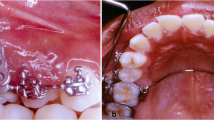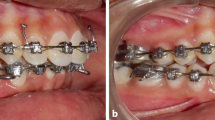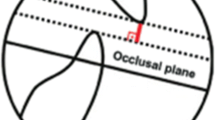Abstract
Background
The interest of this case report is the evaluation of the correlation between the condylar pathways and incisor guidance recorded by computerized axiography and functional cephalometry analysis before and after therapy with the “Function Generating Bite” (FGB-D) appliance for deep bite correction.
Methods
A 12-year-old Italian male patient affected by deep bite was treated with the functional appliance FGB-D to correct the malocclusion. Computerized axiography and functional cephalometry analysis were performed before and after therapy to evaluate the temporomandibular joint function (TMJ).
Results
The results showed an improvement of morphology and symmetry of the axiographic tracings and in particular a very good coordination between condylar movement and incisal guide.
Conclusions
The FGB-D appliance is a useful appliance to correct deep bite dental malocclusions improving occlusion and TMJ function.


Similar content being viewed by others
References
Ahlgren J. Pattern of chewing and malocclusion of teeth: a clinical study. Acta Odontol Scand. 1967;25:3–13.
Gibbs CH, Messerman T, Reswick JB, Derda HJ. Functional movements of the mandible. J Prosthet Dent. 1971;57:306–12.
Anders C, Harzer W, Eckardt L. Axiographic evaluation of mandibular mobility in children with angle class-II/2 malocclusion (deep overbite). J Orofac Orthop. 2000;61:45–53.
Piancino MG, Roberi L, Frongia G, Reverdito M, Slavicek R, Bracco P. Computerized axiography in TMD patients before and after therapy with ‘function generating bites’. J Oral Rehabil. 2008;35:88–94.
Zimmer B, Schwestka R, Kubein-Meesenburg D. Differences of clinical and axiographic function parameters in patients with skeletal Class II and Class III anomalies. Dtsch Zahnarztl Z. 1989;44:72–75.
Slavicek R. Prinzipien der Okklusion. Inf Orthod Kieferorthop. 1982;14:171–212.
Zoghby AE, Rè J-P, Perez C. Functional harmony between the sagittal condylar path inclination and the anterior guidance inclination. J Stomat Occ Med. 2009;4:131–136.
Stamm T, Vehring A, Ehmer U, Bollmann F. Computer-aided axiography of asymptomatic individuals with Class II/2. J Orofac Orthop. 1998;59:237–45.
Hausser E. Structure of the mandibular joint in different abnormalities of the dentition. Dtsch Zahn Mund Kieferheilkd Zentralbl Gesamte. 1952;16:266–89.
Slavicek R. Die funktionellen Determinanten des Kauorgans. Munchen: Zahnärztlich-Medizinisches Schrifttum; 1984.
Bracco P, Solinas GF. Orthognatic correction of uni- and bilateral crossbite with a functional appliance. Mondo Orthtod. 1979;4:8–24.
Castroflorio T, Talpone F, Deregibus A, Piancino MG, Bracco P. Effects of a functional appliance on masticatory muscles of young adults suffering from muscle-related temporomandibular disorders. J Oral Rehabil. 2004;31:524–9.
Piancino MG, Bracco P, Vallelonga T, Merlo A, Farina D. Effect of bolus hardness on the chewing pattern and activation of masticatory muscles in subjects with normal dental occlusion. J Electromyogr Kinesiol. 2008;18:931–7.
Piancino MG, Talpone F, Dalmasso P, Debernardi C, Lewin A, Bracco P. Reverse-sequencing chewing patterns before and after treatment of children with a unilateral posterior crossbite. Eur J Orthod. 2006;28:480–4.
Slavicek R. Clinical and instrumental functional analysis for diagnosis and treatment planning. Part 5. Axiography. J Clin Orthod. 1988;2:656–67.
Mantout B, Giraudeau A, Perez C, Ré J-P, Orthlieb J-D. Technical validation of a computerized condylographic system. J Stomat Occ Med. 2008;1:45–50.
Piehslinger E, Celar A, Celar R, Jäger W, Slavicek R. Reproducibility of the condylar reference position. J Orofac Pain. 1993;7:68–75.
Piehslinger E, Celar AG, Celar RM, Slavicek R. Computerized axiography: principles and methods. J Craniomand Pract. 1991;9:344–55.
Piehslinger E, Ertl L. Computerized axiography for standardized evaluation of TMJ function and dysfunction. Medinfo. 1995;8:1303–4.
Nitzan DW. Friction and adhesive force-possible underlying causes for temporomandibular joint internal derangement. Cells Tissues Organs. 2003;174:6–16.
Nitzan DW, Nitzan U, Dan P, Yedgar S. The role of hyaluronic acid in protecting surface-active phospholipids from lysis by endogenous phospholipase A(2). Rheumatology (Oxford). 2001;40:336–40.
Pullinger AG, Seligman DA. Quantification and validation of predictive values of occlusal variables in temporomandibular disorders using a multifactorial analysis. J Prosthet Dent. 2000;83:66–75.
Thilander B, Rubio G, Pena L, de Mayorga C. Prevalence of temporomandibular disorders and its association with malocclusion in children and adolescents: an epidemiologic study related to specific stages of dental development. Angle Orthod. 2002;72:146–54.
Acknowledgements
This research was partially supported by a grant of the Italian Ministry of Research.
Author information
Authors and Affiliations
Corresponding author
Rights and permissions
About this article
Cite this article
Reverdito, M., Piancino, M., Frongia, G. et al. Functional cephalometry analysis and computerized axiography before and after therapy with “Function Generating Bite” in a deep bite patient. J. Stomat. Occ. Med. 4, 67–71 (2011). https://doi.org/10.1007/s12548-011-0010-y
Received:
Accepted:
Published:
Issue Date:
DOI: https://doi.org/10.1007/s12548-011-0010-y




